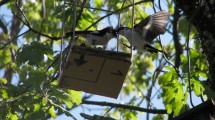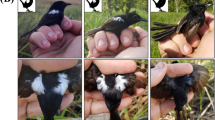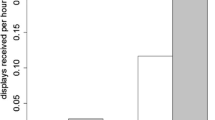Abstract
In groups ofGorilla g. beringei, male aggression towards females regularly takes the form of male display. This paper examines male display towards females in two Karisoke study groups (Group 5 and Group BM) in 1989, a period when none of the females were new immigrants. Results are based on 259 hr of focal observations and 121 hr ofad libitum observations on male behaviors towards females. The goal is to see if the data are compatible with four non-mutually exclusive hypotheses to explain male displays towards females: (1) demonstration of male fighting abilities to influence female long term residence decision; (2) decrease potential competitive inequities between females; (3) provision to females of an occasion to confirm their subordinance to a male; and (4) short term influence on mating. First, male-female proximity was tested against proportion of male displays, to rule out the possibility that males display towards females simply because they happen to be close by. There was no association between proximity and male display. Dominant males were responsible for a higher proportion of displays than subordinate males. This is consistent with the idea that males display to demonstrate their fighting abilities, or their qualities as protector, since dominant males are the ones offering long term protection against infanticide and predators. Females that were in a position to transfer did not receive a higher proportion of male display, however. Long term resident dominant females received a higher proportion of displays from the dominant males, which is consistent with the idea that males attempt to decrease potential competitive inequities between females. There was an association between female appeasement reactions and male displays, which suggests that males display to create occasions for the females to confirm their subordinance to them. Estrous females did not receive a higher proportion of male displays, and there was no association between male display and copulation, suggesting that male displays are not a form of courtship aggression aimed at influencing mating in the short term.
Similar content being viewed by others
References
Appleby, M. C. 1983. The probability of linearity in hierarchies.Anim. Behav., 31: 600–608.
Clutton-Brock, T. H.;Parker, G. A. 1995. Sexual coercion in animal societies.Anim. Behav., 49: 1345–1365.
Cords, M. 2000. Mixed-species association and group movement. In:On the Move: How and Why Animals Travel in Groups,Boinski,S.;Garber,P. S. (eds.), Univ. of Chicago Press, Chicago, pp. 73–99.
Fossey, D. 1984. Infanticide in mountain gorillas (Gorilla gorilla beringei) with comparative notes on chimpanzees. In:Infanticide: Comparative and Evolutionary Perspectives,Hausfater,G.;Hrdy,S. B. (eds.), Aldine Press, New York, pp. 217–235.
Goodall, J. 1986.The Chimpanzees of Gombe. Belknap, Harvard.
Harcourt, A. H. 1978. Strategies of emigration and transfer by primates, with particular reference to gorilla.Z. Tierpsychol., 48: 401–420.
Harcourt, A. H. 1979a. Social relationships among adult female mountain gorilla.Anim. Behav., 27: 251–264.
Harcourt, A. H.. 1979b. Social relatinolships between adult male and female mountain gorillas in the wild.Anim. Behav., 27: 325–342.
Harcourt, A. H. 1981. Intermale competition and the reproductive behavior of the great apes. In:Reproductive Biology of the Great Apes,Graham,C. (ed.), Academic Press, New York, pp. 301–317.
Harcourt, A. H.:Stewart, K. J. 1987. The influence of help in contests on dominance rank in primates: hints from gorillas.Anim Behav., 35: 182–190.
Harcourt, A. H.;Stewart, K. J. 1989. Functions of alliances in contests within wild gorilla groups.Behaviour, 109: 176–190.
Harcourt, A. H.;Stewart, K. J. 1996. Function and meaning of wild gorilla “close calls,” 2: Correlations with rank and relatedness.Behaviour, 133: 827–845.
Harcourt, A. H.;Stewart, K. J.;Fossey, D. 1976. Male emigration and female transfer in wild mountain gorilla.Nature, 263: 226–227.
Harcourt, A. H.;Stewart, K. J.;Hauser, M. 1993. Functions of wild gorilla “close calls,” 1: Repertoire, context, and interspecific comparison.Behaviour, 124: 89–122.
Hayaki, H. 1990. Social context of pant-grunting in young chimpanzees. In:The Chimpanzees of the Mahale Mountains: Sexual and Life History Strategy,Nishida,T. (ed.), Univ. of Tokyo Press, Tokyo, pp. 189–206.
Hess, J. P. 1973. Some observations on the sexual behaviour of captive lowland gorillas,Gorilla g. gorilla (Savage andWyman). In:Comparative Ecology and Behaviour of Primates,Michael,R. P.;Crook,J. H. (eds.), Academic Press, London, pp. 508–581.
Nadler, R. D. 1989. Sexual initiation in wild mountain gorillas.Int. J. Primatol., 10: 81–92.
Nadler, R. D.;Miller, L. C. 1982. Influence of male aggression on mating of gorillas in the laboratory.Folia Primatol., 38: 233–239.
Robbins, M. M. 1995. A demographic analysis of male life history and social structure of mountain gorillas.Behaviour, 132: 21–47.
Robbins, M. M. 1996. Male-male interactions in heterosexual and all-male wild mountain gorilla groups.Ethology, 102: 942–965.
Robbins, M. M. 2001. Variation in the social system of mountain gorillas: the male perspective. In:Mountain Gorillas: Three Decades of Research at Karisoke,Robbins,M. M.:Sicotte,P.;Stewart,K. J. (eds.), Cambridge Univ. Press, Cambridge, pp. 29–57.
Schaller, G. 1963.The Mountain Gorilla. Univ. of Chicago Press, Chicago.
Sicotte, P. 1993. Intergroup interactions and female transfer in mountain gorillas: influence of group composition on male behavior.Amer. J. Primatol., 30: 21–36.
Sicotte, P. 1994. Effect of male competition on male-female relationships in bi-male groups of mountain gorillas.Ethology, 97: 47–64.
Sicotte, P. 2000. A case study of mother-son transfer in mountain gorillas.Primates, 41: 93–101.
Sicotte, P. 2001. Female mate choice in mountain gorillas. In:Mountain Gorillas: Three Decades of Research at Karisoke,Robbins,M. M.;Sicotte,P.;Stewart,K. J. (eds.), Cambridge Univ. Press, Cambridge, pp. 59–87.
Siegel, S.;Castellan, N. J. 1988.Non-Parametric Statistics for the Behavioral Sciences. McGraw Hill, New York.
Smuts, B. B.;Smuts, R. W. 1993. Male aggression and sexual coercion of females in nonhuman primates and other mammals: evidence and theoretical implications.Adv. Stud. Behav., 22: 1–63.
Sokal, R. R.:Rohlf, F. J. 1981.Biometry. W. H. Freeman, New York.
Stewart, K. J.;Harcourt, A. H. 1987. Gorillas: variation in female relationships. In:Primate Societies,Smuts,B. B.;Cheney,D. L.;Seyfarth,R. M.;Wrangham,R. W.;Struhsaker,T. T. (es.), Univ. of Chicago Press, Chicago, pp. 155–164.
Watts, D. P. 1989. Infanticide in mountain gorillas: new cases and a reconsideration of the evidence.Ethology, 81: 1–18.
Watts, D. P. 1991. Mountain gorillas reproduction and sexual behavior.Amer. J. Primatol., 24: 211–225.
Watts, D. P. 1992. Social relationships of immigrant and resident female mountain gorillas, I: Malefemale relationships.Amer. J. Primatol., 28: 159–181.
Watts, D. P. 1994. Agonistic relationships between female mountain gorillas (Gorilla gorilla beringei).Behav. Ecol. Sociobiol., 34: 347–358.
Watts, D. P. 1995. Post-conflict social events in wild mountain gorillas (Mammalia, Hominoidea), I: Social interactions between opponents.Ethology, 100: 139–157.
Watts, D.P. 1997. Agonistic interventions in wild mountain gorilla groups.Behaviour, 134: 23–57.
Watts, D. P. 2000. Causes and consequences of variation in male mountain gorilla life histories and group membership. In:Primate Males: Causes and Consequences of Variation in Group Composition, Cambridge Univ. Press, Cambridge, pp. 169–179.
Wrangham, R. W. 1979. On the evolution of ape social system.Soc. Sci. Inform., 18: 334–368.
Author information
Authors and Affiliations
About this article
Cite this article
Sicotte, P. The function of male aggressive displays towards females in mountain gorillas. Primates 43, 277–289 (2002). https://doi.org/10.1007/BF02629603
Received:
Accepted:
Published:
Issue Date:
DOI: https://doi.org/10.1007/BF02629603




